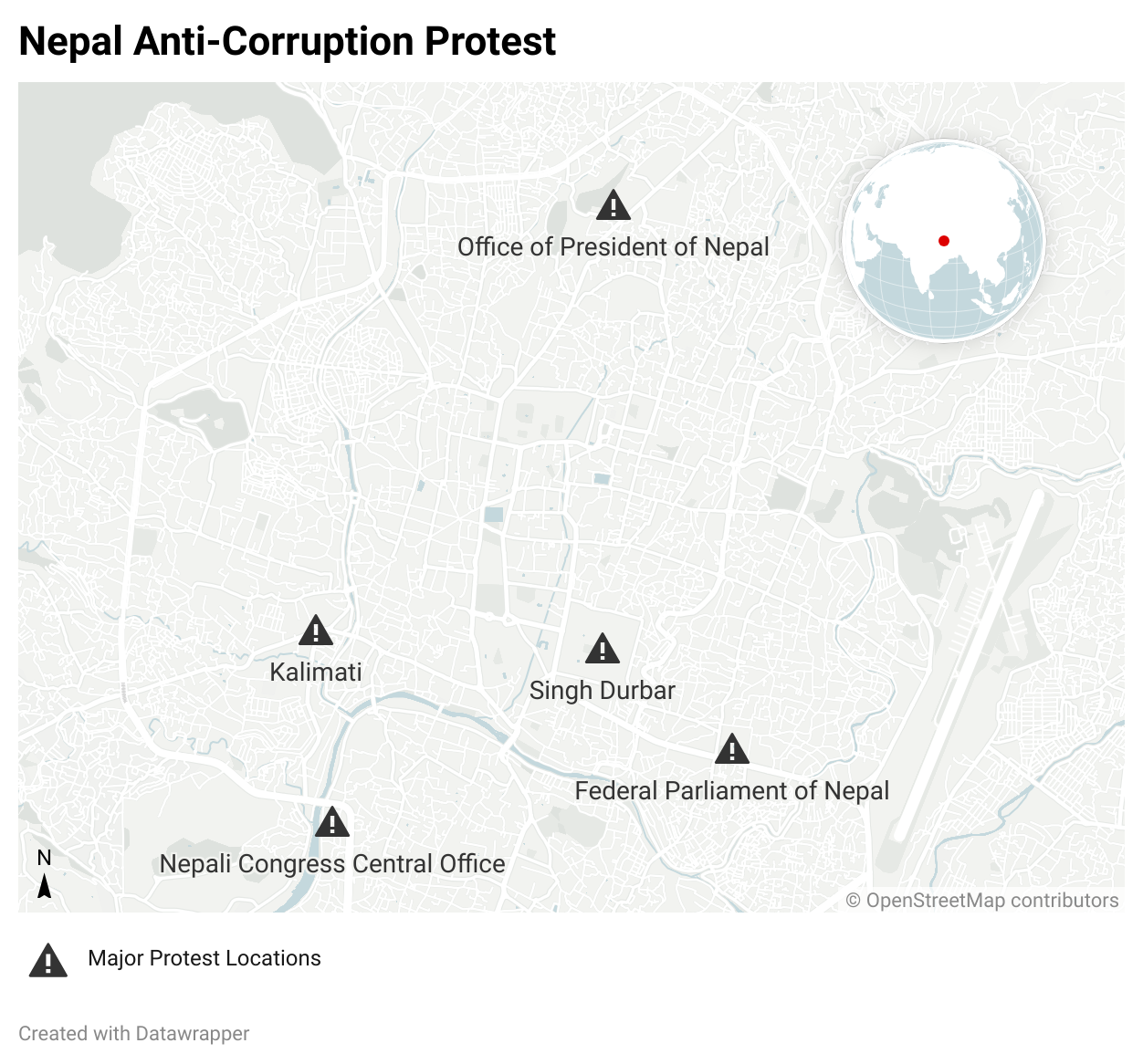Nepal Gen-Z-led Anti-Corruption Protests
By Divya Narvekar | 19 September 2025
Summary
On 4 September, Nepal banned 26 social media platforms, sparking youth-led Gen Z protests. Demonstrations, starting in Kathmandu, later escalated into nationwide unrest, leaving 72 dead, 400 injured, forcing then Prime Minister K.P. Sharma Oli and other ministers to resign.
Nepal had been facing deeper problems such as corruption, political instability, nepotism, and unemployment.
On 12 September, former Chief Justice Sushila Karki was appointed the first female PM of Nepal and recommended the dissolution of Parliament.
On 4 September, the Nepalese government banned 26 popular social media platforms, including Facebook, WhatsApp, Instagram, X, and YouTube, citing regulatory noncompliance. This ban triggered nationwide protests, led by “Gen Z”, on 8 September. While the ban was a catalyst for the current unrest, the protests were rooted in deeper dissatisfaction with government corruption, nepotism, economic stagnation, and lack of opportunities for young people. Even before the protests were held, there was a deep dissatisfaction among the youth of Nepal with the politicians and the government. Social media was the medium through which youths would vent their anger about these problems. In the days leading up to the ban and protests, the hashtags #nepokids and #nepobabies showcased the youths’ dissatisfaction with the children of politicians and businessmen allegedly enjoying lives fuelled by corruption.
The protests turned violent, with 72 protesters killed and hundreds injured in clashes with security forces. Protesters set the parliament building and other government properties on fire. Roads were blocked with burning tyres, and demonstrators shouted slogans such as “KP Chor, Desh Chhod” and “Take action against corrupt leaders.” Security forces used water cannons, tear gas, and live ammunition. On Tuesday, 9 September, thousands of Gen Z demonstrators clashed with authorities for a second consecutive day, storming the homes of several leaders and setting fire to the private residences of the then Prime Minister Oli’s in Balkot and Communication Minister Prithvi Subba Gurung's in Sunakothi in Lalitpur. Nepal’s PM Oli and Nepal’s Agriculture Minister Ram Nath Adhikari resigned amid violent protests in Kathmandu over alleged corruption. Due to the prevailing situation, the army took control of the situation on 9 September and imposed curfews across the country.
Hami Nepal, the group that organised the protests, held a call on the messaging application Discord to choose Nepal’s interim prime minister. After hours of discussion, the strongest push ultimately centred on Sushila Karki for her integrity. Right after Karki's appointment, the parliament was dissolved and fresh elections announced for 5 March 2026.
Implications
Economic impact - The resignation of Prime Minister Oli marks political vulnerability. The movement’s demands extend beyond leadership changes; protesters are calling for systemic reforms and accountability. Even though the social media ban is lifted and Oli has resigned, youth unrest persists, fueled by deeper frustrations with entrenched corruption and stagnant economic prospects. Disruptions at the capital, airport, and in transport may hinder investor confidence and tourism, potentially worsening youth unemployment. Remittances, which make up nearly a quarter of Nepal’s GDP, may not offset these losses if prolonged unrest undermines financial stability.
Human rights concerns - Deadly crackdowns raise serious human rights concerns. International scrutiny, especially from the UN and human rights agencies, may intensify. Even before the recent protests, Nepal had been under scrutiny for shrinking civic space. The government frequently employed restrictive laws, including the Electronic Transactions Act (ETA) and defamation provisions, to curb free expression and target journalists, activists, and online dissenters. Foreign direct investment (FDI) may weaken due to political volatility, regulatory uncertainty, and security risks.
Regional effect - Nepal’s unrest is a domestic crisis with regional consequences. The unrest has implications for South Asia’s stability, particularly given Nepal’s geopolitical position between India and China. India’s interests are most immediately threatened, while China and Western states may seek to fill the vacuum. Moreover, prolonged instability could encourage migration pressures into India, creating new social and security challenges across the border.
After days of violence, curfew has been lifted from Kathmandu. Public transport has resumed, and cross-border movement between India and Nepal has reopened. However, restrictions remain in six parts of the capital. Public gatherings of more than five people are banned. Hunger strikes, rallies, sit-ins, and protests remain prohibited for two months under government orders.
हिमाल सुवेदी/Wikimedia Commons, CC BY-SA 4.0
Forecast
Short-term (Now - 3 months)
Security forces are highly likely to remain deployed to maintain order.
Ongoing protests have a realistic possibility to shift from street demonstrations to sit-ins, online activism, or localised rallies.
Medium-term (3-12 months)
Political volatility will likely continue.
Long-term (>1 year)
Nepal will likely enter a phase of political transformation, possibly culminating in early elections, constitutional revisions, or governance restructuring.
Economic strain will almost certainly exacerbate social tension.



